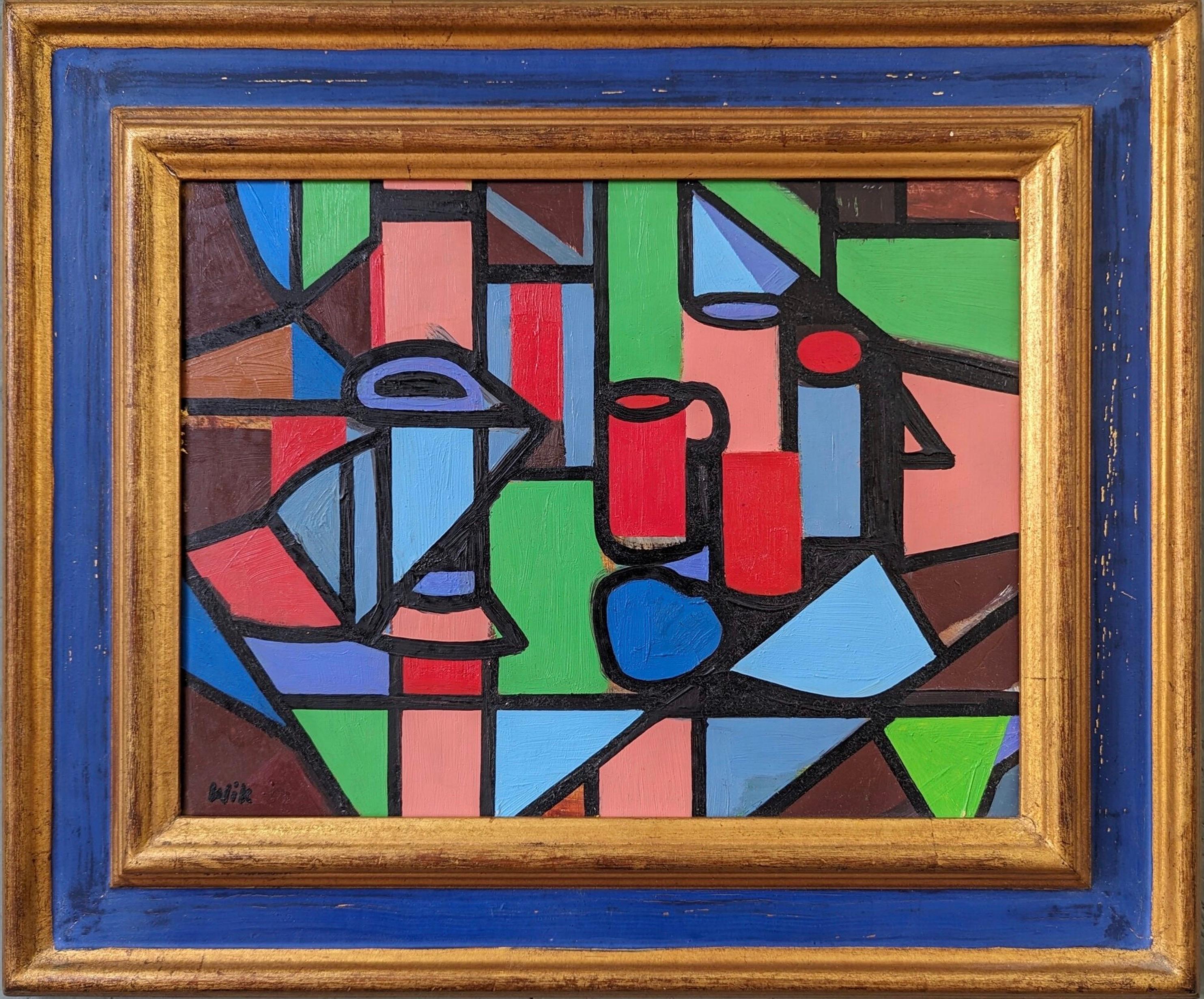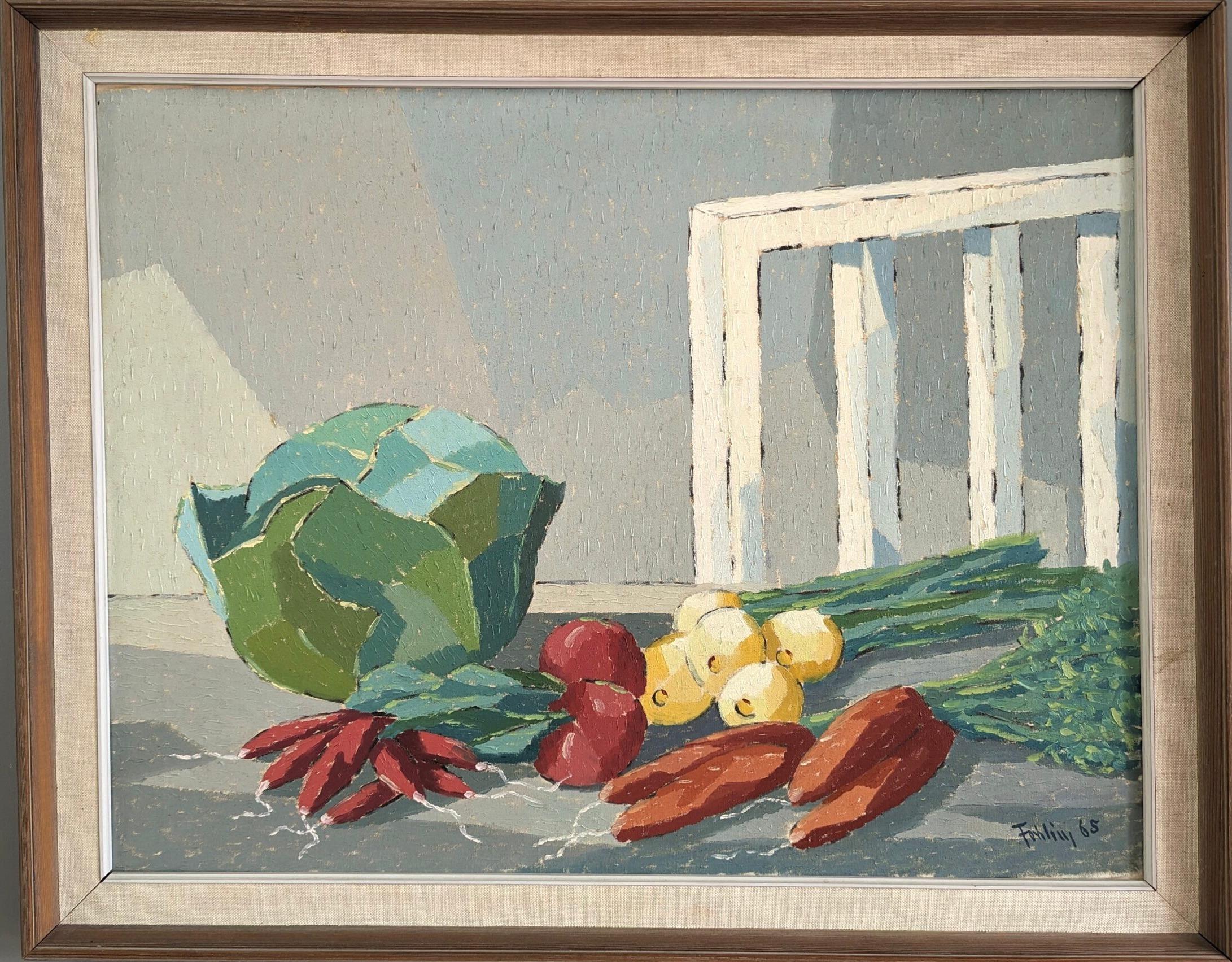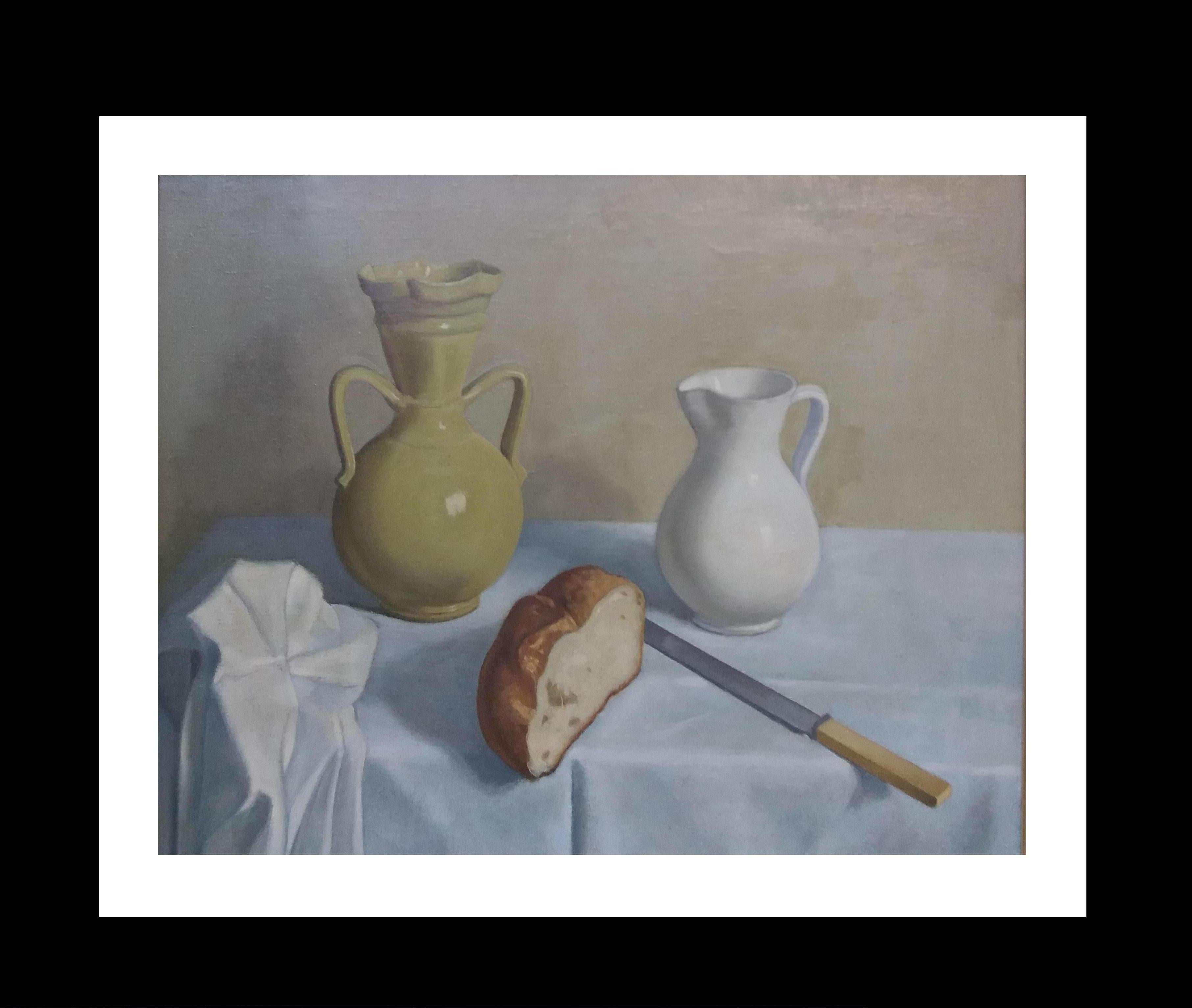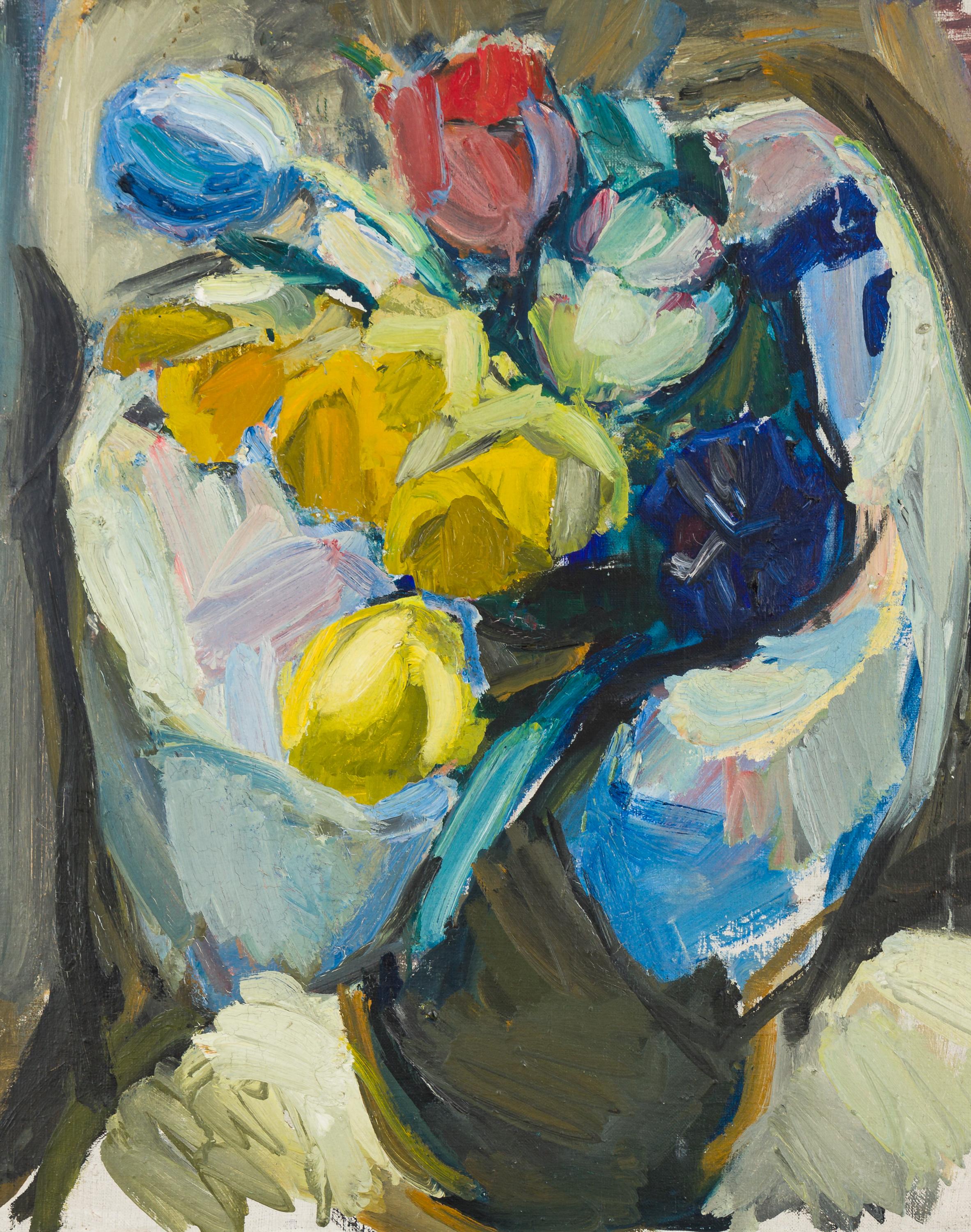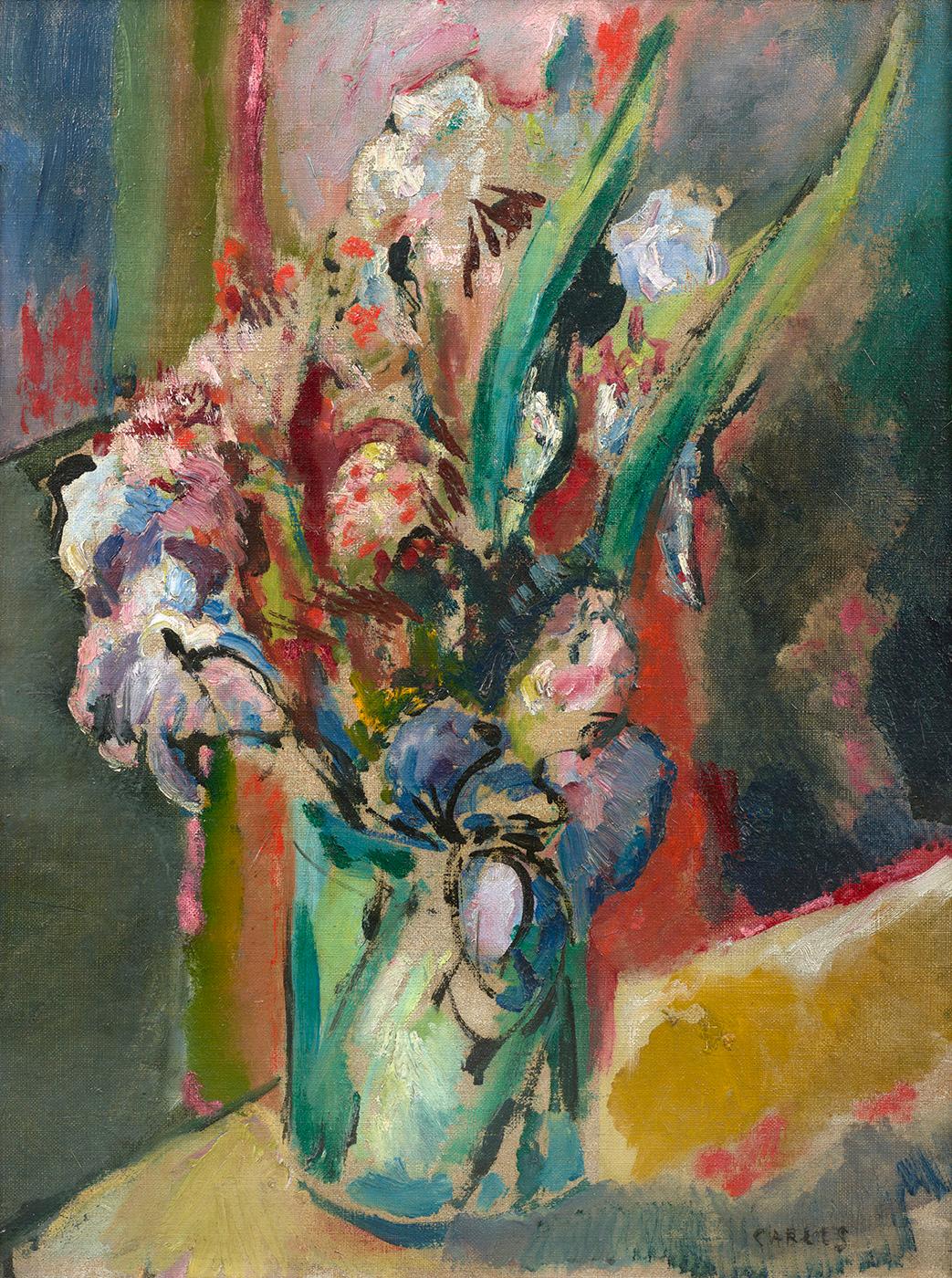Items Similar to "Fruit" Georgina Klitgaard, Apples and Pears Still Life, Woodstock Female Artist
Want more images or videos?
Request additional images or videos from the seller
1 of 11
Georgina Klitgaard"Fruit" Georgina Klitgaard, Apples and Pears Still Life, Woodstock Female Artist
About the Item
Georgina Klitgaard
Apples and Pears Still Life
Signed lower right
Oil on canvas
8 x 10 inches
Georgina Klitgaard’s art has sometimes gotten lost in the critical propensity to assign artists to membership in one school or another. Unfortunately for her posthumous reputation, Klitgaard defied easy characterization. She was a U.S. modernist, working in both oil and watercolors, but never abandoned figurative painting. She made her reputation in landscape but also excelled in portraits, flower studies, and even cityscapes. Yet despite Klitgaard’s ambiguous status in art history, her paintings continue to fascinate viewers attracted to the unsteady ground between twentieth-century realism and expressionism.
Georgina Klitgaard (née Berrian) was born in Spuyten Duyvil, New York (now part of the Bronx); the Berrians had lived in the area since at least the U.S. Revolution. After graduating from Barnard College, she studied art at the National Academy of Design. In 1919 she married Kay Klitgaard, a Danish artist and writer. The next year, her life took a decisive turn when the couple visited friends in Woodstock, NY—about 120 miles north of New York City--and fell in love with the area.
In 1906, L. Birge Harrison helped found the Art Students League Summer School in Woodstock and the area became a magnet for landscape painters. The Klitgaards bought a house in 1922 on a steep ledge at the end of Cricket Ridge, high above Bearsville, which provided panoramic vistas overlooking the Catskill Mountains and the Hudson Valley. Klitgaard joined the artists’ colony in the area, which at the time included artists Ernest Fiene and Katherine Schmidt.
Klitgaard exhibited widely and her career slowly developed momentum. She was a regular contributor at Whitney Museum shows from 1927 to 1944. In 1929, she exhibited a painting entitled “Carousel” in the Whitney Studio Club’s famous exhibition “Circus in Paint.” Gertrude Vanderbilt Whitney acquired five paintings by Klitgaard in the early 1930s and served as a significant patron for the artist. Klitgaard s New York dealer, Frank Rehn Galleries, exhibited her work from 1930 through the 1950s.
During the Great Depression, the Works Progress Administration commissioned Klitgaard to create murals for three U.S. post offices: Goshen (1937) and Poughkeepsie (1940) in New York, and Pelham, Georgia (1941). Klitgaard’s Goshen mural, “The Running of the Hambletonian Stake,” was controversial for featuring harness racing, a theme still considered of questionable taste for public art even though it was the village’s claim to fame.
Although Klitgaard had a studio 659 Fifth Avenue in New York City, she traveled widely in the United States including New England, Florida, and the Santa Fe area. In 1933, Klitgaard received a Guggenheim Fellowship which provided money for her to tour Europe. Seven years later, the family traveled the United States while Kaj used the trip as background for his book, Through the American Landscape (published in 1941).
However, the bulk of Klitgaard’s work was painted around the Woodstock area. She was best known for wide landscapes of her beloved upstate New York, sometimes drifting into a tonalist preoccupation with seasons, mists, sunrises, and atmosphere. Klitgaard achieved her effects by limiting her palette and attempting to reduce her composition to a few simple forms. This sense of restraint allowed her to retain a sense of place and approach abstraction without jettisoning figurative landscapes. One critic wrote that her Woodstock landscapes looked like “Currier and Ives lithographs with little clouds and precise arrangements of facts.” Lloyd Goodrich, the noted art historian, praised her “lively sense of movement and a feeling for light and air with a sort of cool detached lyricism.”
When Klitgaard died in 1976, she seemed out of fashion, detached from almost all postwar art trends. However, in the twenty-first century, she has benefitted from the renewed interest in the prominent female modernists who prospered during the interwar years. Her paintings remain exemplary examples of conservative American modernism.
- Creator:Georgina Klitgaard (1893-1976, American)
- Dimensions:Height: 13 in (33.02 cm)Width: 15 in (38.1 cm)
- Medium:
- Movement & Style:
- Period:
- Condition:
- Gallery Location:New York, NY
- Reference Number:1stDibs: LU1841214091352
Georgina Klitgaard
Georgina Berrian was born in Spuyten Duyvil, New York in 1893. She was educated at Barnard College and studied at the National Academy of Design in New York. She married the Danish-born mariner, artist, and writer Kaj Klitgaard in 1919. After visiting friends in Woodstock, the couple became committed to the area and built a home in 1922 in Bearsville which provided a panoramic view of the mountains and valleys of Woodstock. Georgina Klitgaard's first exhibition in New York was held at the Whitney Studio Club from Dec.20, 1927 to January 7, 1928. Klitgaard's New York dealer was the Frank Rehn Galleries, where she began to exhibit in the 1930s, continuing that relationship into the 1950s. In 1939 and again in 1940 she had solo exhibitions with the Milch Gallery in New York. By the late 1920s, Klitgaard began to show works at museum invitationals. She sent work to the Carnegie International in Pittsburgh, Pennsylvania each year from 1928 to 1949. The Corcoran Gallery of Art in Washington, DC invited Klitgaard to exhibit each year from 1930 to 1945. Klitgaard also exhibited works at the Virginia Museum of Fine Art in Richmond and the Pennsylvania Academy of the Fine Arts in Philadelphia from 1930 to 1945 annually. Klitgaard was also invited to exhibit regularly at the Whitney Museum of American Art from 1927 to 1944. In the 1936 works on paper component of the Whitney Biennial, Klitgaard exhibited Florida Landscape (No.116, a work on paper). In 1944 Klitgaard exhibited another Florida work, Early Spring, Florida (No. 7) at the Whitney. Based on this information, it seems likely that Klitgaard began to visit Florida in the winter during the 1930s and continued to do so until the 1940s. Many of her Woodstock artist friends, such as Doris Lee (1905-1983), found a way to spend time in Florida during the winter on a regular basis. Their experiences in Florida may have influenced Klitgaard to visit. In 1933 Georgina Klitgaard received a Guggenheim Fellowship which provided funds to travel in Europe. In 1940 the family traveled around the U.S. while Kaj, himself now the recipient of a Guggenheim, wrote Through the American Landscape. During the Depression she was selected to paint murals in post offices in Pelham, Georgia and Goshen (1937) and Poughkeepsie (1940) in Upstate New York. The Metropolitan Museum of Art acquired Girl and Child Under A Pine Tree, a colorful portrait, in 1939. By the 1940s Klitgaard's work was also in the permanent collections of the Whitney Museum of American Art; the Newark Museum; the New Britain Museum of American Art; and the Dayton Art Institute, as well as other public and private collections. Klitgaard was a member of the Audubon Artists and the American Society of Painters, Sculptors, and Gravers. She had a studio in New York City located at 659 Fifth Avenue. Klitgaard died in 1976. The bulk of her exhibited subjects were painted around the Woodstock or Bearsville area.
About the Seller
5.0
Platinum Seller
These expertly vetted sellers are 1stDibs' most experienced sellers and are rated highest by our customers.
Established in 2021
1stDibs seller since 2022
63 sales on 1stDibs
Typical response time: <1 hour
- ShippingRetrieving quote...Ships From: New York, NY
- Return PolicyA return for this item may be initiated within 3 days of delivery.
More From This SellerView All
- "Floral Still Life Arrangement" Frederick Jessup, Butterflies, Wine BottleBy Robert JessupLocated in New York, NYFrederick Arthur Jessup Still Life Arrangement Signed lower left Oil on canvas 18 1/2 x 22 inches Provenance: Findlay Galleries, New York Private Collection, New YorkCategory
Mid-20th Century Modern Still-life Paintings
MaterialsCanvas, Oil
- "Still Life of Fruit, " Albert Swinden, American Abstract Association, AAABy Albert SwindenLocated in New York, NYAlbert Swinden (1901 - 1961) Still Life of Fruit, 1937 Oil on canvas 18 x 30 inches Provenance: Graham Gallery, New York Albert Swinden (1901–1961) was an English-born American abstract painter. He was one of the founders of the American Abstract Artists, and he created significant murals as part of the Federal Art Project. Albert Swinden was born in Birmingham, England in 1901. When he was seven, he moved with his family to Canada, and in 1919 he immigrated to the United States. He lived in Chicago, where he studied for about a year and a half at the Art Institute. He then relocated to New York City, where his art education continued briefly at the National Academy of Design. He soon changed schools again, to the Art Students League, which he attended from 1930 to 1934. He studied with Hans Hofmann and gained an appreciation for Synthetic Cubism and Neoplasticism. According to painter and printmaker George McNeil, Swinden "could have influenced Hofmann ... He was working with very, very simple planes, not in this sort of Cubistic manner. Swinden was working synthetically at this time." While still a student, Swinden began teaching at the Art Students League, in 1932. Swinden married Rebecca Palter (1912–1998), from New York. Their daughter, Alice Swinden Carter, also became an artist. Carter, who attended the School of the Museum of Fine Arts, Boston, received an award from the Institute of Contemporary Art, Boston for her large sculptures. Swinden was hired for the Federal Art Project (FAP) of the Works Progress Administration (WPA), and he is best known for the murals which he painted as part of that project. In 1935, New York City Mayor Fiorello La Guardia attended the opening of the inaugural exhibit at the Federal Art Project Gallery, accompanied by Audrey McMahon, New York regional director for the Works Progress Administration/Federal Art Project. Among the works on display was Abstraction, a sketch by Swinden; it was the design for a mural planned for the College of the City of New York. A newspaper account described it as consisting of "brightly colored T-squares, triangles and rulers in horizontal, vertical and diagonal positions". La Guardia asked what it was, and upon being told it was a mural design, he said he didn't know what it depicted. Someone joked that it could be a map of Manhattan. The displeased mayor stated that "if that's art, I belong to Tammany Hall." (Tammany Hall, which the Republican mayor referenced, was the New York Democratic Party political society.) Fearing that the mayor's negative attitude could jeopardize the future of abstract art within the Federal Art Project, McMahon dispatched an assistant to summon an artist who could speak to the mayor in defense of abstraction. The assistant returned with Arshile Gorky. Swinden played an important role in the founding of the American Abstract Artists. In 1935, he met with three friends, Rosalind Bengelsdorf, her future husband Byron Browne, and Ibram Lassaw, with the goal of exhibiting together. The group grew and started meeting in Swinden's studio, which adjoined those of Balcomb and Gertrude Greene...Category
1930s Modern Still-life Paintings
MaterialsCanvas, Oil
- "Sunflowers, " Frank London, Modernist Yellow Floral Still Life with WindowLocated in New York, NYFrank Marsdon London (1876 - 1945) Sunflowers Oil on canvas 31 x 22 inches Signed lower right Exhibited: Pittsburgh, Carnegie Museum of Art. Frank Marsden London was born in the small Southern town of Pittsboro in central North Carolina in 1876. When he reached adulthood, London attended the University of North Carolina...Category
1920s American Modern Still-life Paintings
MaterialsOil, Canvas
- "Ethnographic Still Life, " Edith Kramer, African Mask and Shofar, Art TherapyBy Edith KramerLocated in New York, NYEdith Kramer (1916 - 2014) Still Life with Mask, n.d. Oil on canvas 26 x 20 inches Signed and titled on the stretcher Provenance: Estate of the artist Kramer was born in Vienna, Austria-Hungary in 1916. At age 13 Kramer began art lessons with Friedl Dicker. Dicker was graduate of the Bauhaus in Weimar, Germany and was an artist and art teacher of note. Kramer studied drawing, sculpture and painting, and was influenced by the method for teaching art developed by Bauhaus artist Johannes Itten. It was in 1934 after Kramer graduated from Realgymnasium that she, then 18, followed Dicker to Prague to continue to study under her. During this time in Prague, Kramer witnessed the therapeutic impact of art when she assisted Dicker in teaching art to the children of political refugees. With the threat of Nazi invasion looming, Kramer took refuge in America in 1938. In New York City, she worked for three years teaching sculpture at a progressive school called the Little Red School House. During World War II Kramer worked as a machinist at a tool and die shop in the Soho district of New York City. She stayed after her shift to draw the other workers in their industrial setting. These works were rendered in the social realist style. In 1947 Kramer visited some of the earliest known artwork, in the caves at Lascaux. Kramer spoke of these cave paintings as an example of the universal language of art. At the age of 33 she returned to New York City, with hopes of making a living as an artist. Still in her 33rd year, Kramer was offered a job at Wiltwyck School for Boys, a school and residential treatment facility for children with behavioral and emotional needs. This job was arranged for her by psychoanalyst and board member at Wiltwyck, Dr. Viola Bernard. Dr. Bernard gave Kramer the title, "Art Therapist," noting that few teachers were willing to work with such challenging students. It was here that Kramer worked with disturbed boys, ages 8 through 13, for the following seven years. Raised in a family which was interested in psychoanalytic theory, Kramer herself became a follower of Sigmund Freud. Kramer especially believed in the concept of sublimation. Freudian theory describes sublimation as a process in which primitive urges coming from the id are transformed into socially productive activities that lead to gratification of the original urge. Kramer's training was in art, art education and psychoanalytically informed psychotherapy. Kramer believed sublimation to be one of the most vital goals of art therapy...Category
20th Century American Modern Still-life Paintings
MaterialsCanvas, Oil
- "Lemons and Pear" Marsden Hartley, Colorful Fruit Still Life, Modern ArtBy Marsden HartleyLocated in New York, NYMarsden Hartley Lemons and Pear, circa 1922-23 Oil on canvas 9 x 10 3/4 inches Provenance: Adelaide Shaffer Kuntz, Bronxville (Hartley’s friend and patron) Bertha Schaefer Gallery, New York (acquired from the above) Private Collection, Stamford, Connecticut (acquired from the above) Barridoff Galleries, Portland, Maine, April 7, 1984, Lot 29 (as Still Life with Pear and Lemons) Richard Ward Foster (acquired at above sale) Sotheby's New York, American Art, October 6, 2017, Lot 32 Private Collection (acquired from the above) Exhibited: (possibly) Kantstrasse, Berlin, Private showing in artist’s studio, 1923. (possibly) New York, Bertha Schaefer Gallery, Still Life Painting by European and American Painters, 1944. Born in Lewiston, Maine, Marsden Hartley became one of the most famous early modernist artists of twentieth-century American art, known for landscapes, still lifes, and some portraits. His painting showed a focus on monumental shapes, especially clouds and landscape forms, and his unique style has been described by critic Sadakichi Hartmann as "an extreme and up-to-date impressionism" and "emerging modernism that evolved through Impressionism". (Gerdts 291) He had a lonely, insecure childhood because his mother died when he was eight years old, and he was raised by an older sister when his father left to remarry. He studied art in Cleveland, Ohio and then in 1898 went to the Chase School in New York and at the National Academy of Design. He continued to spend much time in Maine painting landscapes, and by 1909 had his first exhibition, which was held at New York Gallery 291, run by Alfred Stieglitz. There he became involved with a social circle of modernists that included Georgia O'Keeffe, Arthur Dove, and John Marin. In 1912, he first went to Europe where he had further exposure to modernism, and from 1913 to 1915 he was in Germany. In Paris, he experimented with Cezanne-like still lifes and was befriended by Gertrude Stein. In Germany, he was influenced by Expressionism, and especially by military pageantry. It is said that his greatest contribution to early 20th-century American modernism has been his brilliant synthetic military icons known as German Officer Portraits. He developed a close homosexual relationship with a handsome young Prussian officer who was killed in World War I. Being encouraged by Stieglitz to explore American subjects, Hartley turned to American Indian objects...Category
1920s Still-life Paintings
MaterialsCanvas, Oil
- "The Tailor Shop" Suzanne Lalique, French Still Life, Measuring Tape, FabricBy Suzanne LaliqueLocated in New York, NYSuzanne Lalique The Tailor Shop, 1929 Signed and dated upper left Oil on canvas 13 x 16 inches Suzanne Lalique was born in 1892, the daughter of René Lalique and Alice Ledru. She wa...Category
1920s Still-life Paintings
MaterialsCanvas, Oil
You May Also Like
- Vintage Mid-Century Cubist Still Life Framed Oil Painting - Geometric Still LifeLocated in Bristol, GBGEOMETRIC STILL LIFE Size: 41.5 x 49.5 cm (including frame) Oil on board A vibrant and playful mid century cubist modernist composition in oil, painted on board. With a focus on sh...Category
1950s Modern Still-life Paintings
MaterialsCanvas, Oil
- 1965 Vintage Mid-Century Modern Swedish Still Life Oil Painting - VegetablesLocated in Bristol, GBSTILL LIFE WITH VEGETABLES Size: 59 x 74 cm (including frame) Oil on Canvas A brilliantly executed modernist style still life composition, executed in oil onto canvas and dated 1965...Category
Mid-20th Century Modern Still-life Paintings
MaterialsCanvas, Oil
- Rafael Illana BREAD JARS original still life acrylic paintingBy Rafael IllanaLocated in CORAL GABLES - MIAMI, FL. BREAD. JARS original still life acrylic painting. Illana, an artist trained in Barcelona and Paris, although heavily self-taught, reduces the forms in his paintings to essentia...Category
Late 20th Century Modern Still-life Paintings
MaterialsCanvas, Oil
- BlumenbildBy Vilma EcklLocated in Wien, 9The extensive work of Vilma Eckl covers a period of more than seventy years. Her incomparable artistic talent and her essential contribution to the history of art can be seen in her ...Category
20th Century Modern Still-life Paintings
MaterialsCanvas, Oil
- Vintage Mid-Century Interior Floral Still Life Framed Oil Painting - Red TulipsLocated in Bristol, GBRED TULIPS Size: 67 x 58 cm (including frame) Oil on Canvas A captivating and well-balanced interior still life composition, executed in oil onto canvas. Upon first glance, a vase ...Category
1960s Modern Still-life Paintings
MaterialsCanvas, Oil
- Still-Life with FlowersBy Arthur Beecher CarlesLocated in New York, NYSigned lower right: CARLESCategory
Early 20th Century Modern Still-life Paintings
MaterialsCanvas, Oil
Recently Viewed
View AllMore Ways To Browse
1940s Still Life
Danish Still Life
Antique Pear
Antique Pears
Antique Fruit Art
High End Antiques
Postwar Art
Early European Modernism
Dior Patron
Antique Still Life Fruit
Fruit Fashion
Fruit Pears
Apple Pear
Apple And Pear
Early 20th Century Female Portraits
Black History Antiques
Danish Female Artists
Studio Twenty Seven
